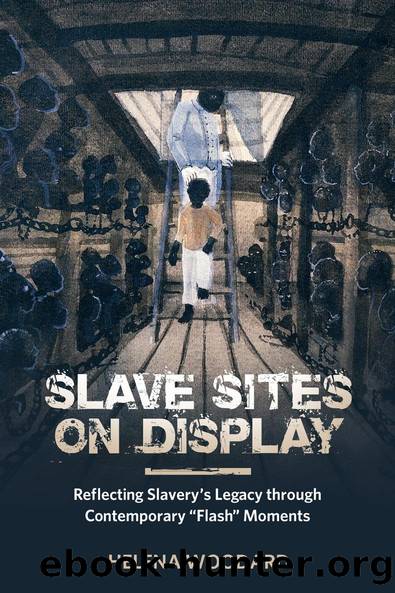Slave Sites on Display by Helena Woodard

Author:Helena Woodard [Woodard, Helena]
Language: eng
Format: epub
Tags: Social Science, Slavery, History, African American & Black, Black Studies (Global), Ethnic Studies, American, African American & Black Studies
ISBN: 9781496824158
Google: cyysDwAAQBAJ
Publisher: Univ. Press of Mississippi
Published: 2019-08-23T05:14:32+00:00
Why Slave Remains Were Relocated to the Hermitage
At the Hermitage estate of President Andrew Jackson in the spring of 2009, officials dedicated a memorial near a site where the remains of sixty slaves had recently been buried. But curiously, these decedents were not directly affiliated with Jackson or his plantation. The sixty enslaved remains were disinterred from their previous burial site on the grounds of a former plantation near the Hermitage in order to clear the way for completion of a development project at the site. While these decedents were not directly affiliated with the Hermitage, they were believed to be slaves from the Ingleside and Cleveland Hall Plantations (also known as the Donelson Plantation) that were owned by Jacksonâs wifeâs nephews. An agreement between the state, the project developer, and the Hermitage led to the bodies being removed and reinterred on the grounds of the Hermitage. The burials took place after archaeologists were unable to locate, definitively, gravesites for Jacksonâs own slaves, in spite of years of searching, reportedly with the aid of cadaver dogs. The exact location of gravesites for Jacksonâs slaves remains undetermined because the cemeteries were unmarked. In light of that futility, transferring the slave remains rather than discarding them made sense, but presumably their disinterment and reinterment would also permit developers to proceed with replacing the former slave cemetery with modern real estate development without protest. But thatâs not exactly how things happened.
Around 2000 a private developer purchased land on a two-acre tract near the Lakewood area in northeastern Nashville in order to construct condominiums tentatively called Hermitage Springs. But the land had already been found in 1998 to be an ancient Native American burial site, which called for special handling of any excavated remains. Similar to the New York African Burial Ground, the cemetery was afforded some legal protection as hallowed ground. Specifically, âTennessee law requires complianceâ with statutes that govern âthe termination of land [used] as a cemetery to legally remove and relocate any human burial [in] Tennessee, including ancient Native American graves.â39 Though a previous owner had not developed the site, the new owner began construction work that unearthed skeletal remains and burial artifacts. When the Tennessee Division of Archaeology was alerted to the situation, the state archaeologist ordered the work halted. The law required the developer to procure a chancery court order to obtain permission to remove human remains from his property. According to Pat Cummins, former president of the Alliance for Native American Indian Rights of Tennessee (the Alliance), construction work continued at the site. The Alliance consulted an attorney to intercede in stopping the work that threatened the graves. Then, in August 2000, a court order ceasing all excavations near the burial ground site was issued.
While Cummins and other Alliance members gained permission from the developer to monitor the site for theft and destruction, construction work continued to desecrate the graves and to destroy artifacts. Cummins writes that by 2004, when archaeologists became involved with the site, their unique
Download
This site does not store any files on its server. We only index and link to content provided by other sites. Please contact the content providers to delete copyright contents if any and email us, we'll remove relevant links or contents immediately.
| Americas | African Americans |
| Civil War | Colonial Period |
| Immigrants | Revolution & Founding |
| State & Local |
In Cold Blood by Truman Capote(3343)
The Innovators: How a Group of Hackers, Geniuses, and Geeks Created the Digital Revolution by Walter Isaacson(2986)
Steve Jobs by Walter Isaacson(2857)
All the President's Men by Carl Bernstein & Bob Woodward(2346)
Lonely Planet New York City by Lonely Planet(2194)
And the Band Played On by Randy Shilts(2163)
The Room Where It Happened by John Bolton;(2132)
The Poisoner's Handbook by Deborah Blum(2108)
The Murder of Marilyn Monroe by Jay Margolis(2076)
The Innovators by Walter Isaacson(2074)
Lincoln by David Herbert Donald(1962)
A Colony in a Nation by Chris Hayes(1900)
Being George Washington by Beck Glenn(1771)
Under the Banner of Heaven: A Story of Violent Faith by Jon Krakauer(1764)
Amelia Earhart by Doris L. Rich(1668)
The Unsettlers by Mark Sundeen(1658)
Dirt by Bill Buford(1649)
Birdmen by Lawrence Goldstone(1637)
Zeitoun by Dave Eggers(1614)
